It’s probably safe to say that most, if not all, youth exhibitors dream of being able to keep their horses, go to college, and continue showing. However, for most, this is logistically unrealistic for a myriad of reasons and the idea of going to college and showing remains nothing more than a pipe dream.
Enter the collegiate equestrian team. Joining an equestrian team is a surefire way to ensure you get the education you desire while simultaneously continuing your passion.
GoHorseShow spoke with four outstanding former youth exhibitors who have all gone on to join a National Collegiate Equestrian Association (NCEA) team. They shared with us what’s different about collegiate competition, its benefits and challenges, how it has helped them become better horsewomen, and shared advice for current youth exhibitors who are considering joining a team when the time comes.
While all four of the young women we talked to enjoyed success in youth competition, what led them to the decision to join an equestrian team was different for each one.
From Youth Rider to Team Member
In 2009, Megan McMullen was named AQHYA World Champion in Showmanship with her horse, Huntin For Money. The idea of joining an equestrian team wasn’t really on her radar until her older sister, AQHYA World Champion, Lindsey, joined the equestrian team at Oklahoma State University.
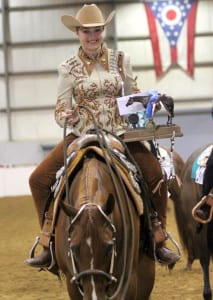 “My sister told me how much the team had benefited her, so my junior year I started focusing more on horsemanship even though I really love western pleasure,” McMullen said. (Western pleasure is not an event in collegiate competition)
“My sister told me how much the team had benefited her, so my junior year I started focusing more on horsemanship even though I really love western pleasure,” McMullen said. (Western pleasure is not an event in collegiate competition)
Needless to say, Lindsey’s inspiration and her hard work paid off as McMullen (pictured right) is now a junior at Texas Christian University majoring in Marketing and seeking a minor in Political Science.
McMullen’s roommate and teammate at TCU, Rylee Morgan (a junior majoring in Sociology with a minor in Political Science) was born into the horse business as her parents are trainers, Shawn and Sandi Morgan.
In 2008, she was #1 on the AJPHA Top Twenty 13 & Under and in 2012, she was named AJPHA Reserve World Champion Hunt Seat Equitation 14-18.
 Morgan (pictured left) has earned 15 World and Reserve Championships but craved a different challenge which is what led her to join the equestrian team.
Morgan (pictured left) has earned 15 World and Reserve Championships but craved a different challenge which is what led her to join the equestrian team.
“I really wanted the challenge of riding different horses,” she said, “My parents are trainers so I’ve always ridden lots of horses but you get longer than five minutes to ride before you show.”
Author’s note: In collegiate competition, riders “draw” the name of a horse out of a hat and receive 5 minutes to warm them up before riding their pattern. They rarely ride the same horse and let’s face it, five minutes?! As we all know, we generally prepare for weeks or months with the same horse before heading to a show.
While McMullen and Morgan were inspired by family and the thrill of doing something totally different, Paris Nottingham from Kansas and Bailey Anderson from Texas were inspired to join a team mainly for financial reasons (albeit, different ones).
 Paris Nottingham, who earned the AQHYA High Point in Showmanship in 2012 with her horse, RL Top Knot and was also 3rd in the Showmanship at the World Show that year said, “In general, it is just a great opportunity for financial assistance for school.”
Paris Nottingham, who earned the AQHYA High Point in Showmanship in 2012 with her horse, RL Top Knot and was also 3rd in the Showmanship at the World Show that year said, “In general, it is just a great opportunity for financial assistance for school.”
Nottingham (pictured right), a senior at Oklahoma State University, majoring in Biochemistry and Molecular Biology, also said knowing girls already on the team helped her make her decision on what team to join.
“I’m a Midwest girl, and I knew several girls on the team already and knew they were great girls,” she said, “I already knew I wanted to join an equestrian team but they helped me make my decision and choose OSU.”
Bailey Anderson also liked the idea of a scholarship helping out with school bills, however, her decision to join a team also centered around what many youth exhibitors face when college time comes.
“I mostly wanted to join a team because my parents said ‘no more’ when it came to paying for horses and shows so it was a way for me to keep horses in my life,” she said.
Anderson, a sophomore at the University of Georgia, is majoring in Biochemical Engineering and was the AQHYA Reserve World Champion in Showmanship and Horsemanship in 2014 and also was in the Top Five in Equitation that same year.
A Different Kind of Competition
It’s already been mentioned that equestrian team members draw a horse and get a measly five minutes to warm up before they show, but how else is it different?
 McMullen said, “It’s actually more competitive than AQHA. You go head to head with one other girl and you have the team element as well. So not only do you want to win for yourself, you want to win for your team.”
McMullen said, “It’s actually more competitive than AQHA. You go head to head with one other girl and you have the team element as well. So not only do you want to win for yourself, you want to win for your team.”
Author’s Note: Unlike breed shows where you compete against any number of exhibitors, in collegiate competition you go head to head with a member of the opposing team, who, oh yeah, rides the same horse as you. It’s a whole new level of competition.
Morgan also mentioned that the whole idea of being on a team is quite a new experience, since we are so accustomed to the one horse, one rider format.
“It’s very different being on a team,” said Morgan, “but it is also amazing knowing that they are behind you and even if you don’t have a great go, your team still has the opportunity to win.”
Anderson added, “The horses are pretty different than (we’re) used to, too. Some of them never get tuned up and obviously you don’t have the time to work on the horse that you do when showing.”
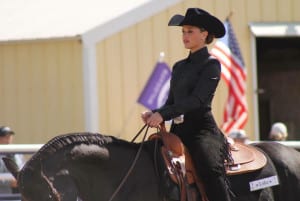 “I love the aspect of not riding the same horse all the time,” said Nottingham, “but there are times when I miss it too. It is incredibly challenging, especially when you travel to different schools and have no idea what is in their barn.”
“I love the aspect of not riding the same horse all the time,” said Nottingham, “but there are times when I miss it too. It is incredibly challenging, especially when you travel to different schools and have no idea what is in their barn.”
Author’s Note: Contrary to popular belief, equestrian team members do not bring their youth horses with them to college. All horses on a team have been donated to the school. While some are incredibly nice stock, obviously, not all of them are. The challenge can clearly be a daunting one.
All of the women said that learning to be a part of a team, adjusting to head to head competition, and learning to ride whatever is underneath you are common challenges most new team members face, but all of them shared some challenges that were unique to each one of them.
McMullen shared the difficulty of pretty much forgetting the idea of training each horse.
 “You’re always concentrating on improving yourself instead of the horse,” she said, “because you have to understand you aren’t going to teach a horse something in five minutes.”
“You’re always concentrating on improving yourself instead of the horse,” she said, “because you have to understand you aren’t going to teach a horse something in five minutes.”
For Morgan, the biggest challenge was coming to terms with the idea that even if you have a bobble, it’s not the end of the world.
“In breed shows, let’s say you mess up your spin or back or whatever, you’re done,” said Morgan, “In collegiate competition you still have the opportunity to win, even if you mess up. So the biggest challenge for me is to keep showing.”
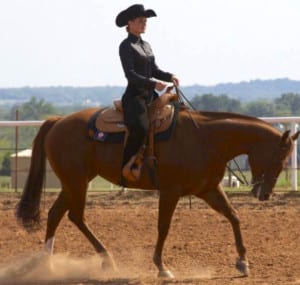 Anderson agreed, “You really have to fake it til you make it in collegiate competition. In AQHA, we could always just school our horse if we blew it. But in collegiate competition you just have to keep going!”
Anderson agreed, “You really have to fake it til you make it in collegiate competition. In AQHA, we could always just school our horse if we blew it. But in collegiate competition you just have to keep going!”
For Nottingham, letting things go has been the biggest challenge. As we all know, this is something breed show competitors struggle with in general, but Nottingham explained why it’s more detrimental in collegiate competition to succumb to that way of thinking.
“The biggest challenge for me is giving yourself a blank slate every time you ride because you are on a different horse every time. So you can’t dwell on a mistake you made on a previous horse.”
Upsides and Benefits
A true competitor embraces challenges because they know it serves to make them better and these equestrians are no exception. They all shared how being a part of an equestrian team has helped them become better equestrians themselves.
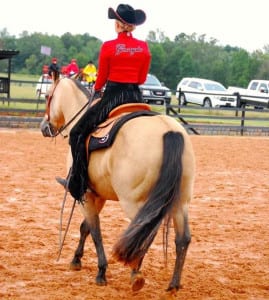 “It helps you to deal with the unexpected and how to ride different horses,” said Anderson, “For example, a lot of Reining horses are also used as Horsemanship horses so it teaches you to approach each horse differently.”
“It helps you to deal with the unexpected and how to ride different horses,” said Anderson, “For example, a lot of Reining horses are also used as Horsemanship horses so it teaches you to approach each horse differently.”
Nottingham agreed, “The two biggest things it has taught me is patience and that there is always more than one way to approach a horse. You have to learn what the horse is capable of very quickly and it has taught me to be good at hiding the horse’s weaknesses.”
“It’s taught me how to figure out the strengths and weaknesses of horses really quick,” added Morgan, “If you can tell you’re not going to get along with the horse you have to figure out how you’re going to get him shown.”
For McMullen, being on an equestrian team has taught her even more: “It’s taught me how to take advice and listen to other girls. On a team, you really have to work with your coach and as a youth rider your parents are usually the one making decisions with your trainer, so since I’ve been on the team, communication has gotten so much easier.”
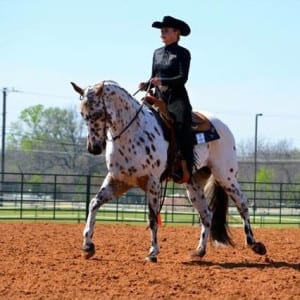 All the women spoke a lot about the team setting and how beneficial it is. Sure, when you are in a supportive show barn you support one another, but at the end of the day, your barn mates are still your competition.
All the women spoke a lot about the team setting and how beneficial it is. Sure, when you are in a supportive show barn you support one another, but at the end of the day, your barn mates are still your competition.
Anderson said, “You just walk into this big group of friends, like a sorority, only you all have the same goals and common interests.”
Nottingham added, “The camaraderie of the girls is irreplaceable. Hopefully, they’ll be lifelong friendships!”
And if you think being on a team takes away from the competitive aspect, Morgan was quick to point out, it is quite the opposite.
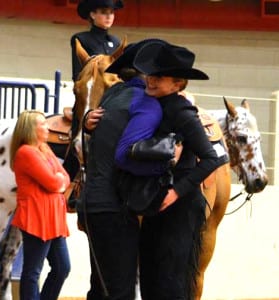 “Having a team support you no matter what really makes it so much more fun while still being super competitive,” she said.
“Having a team support you no matter what really makes it so much more fun while still being super competitive,” she said.
And who can forget what these women really get to do while away at college?
McMullen said it very well, when she said: “I get to ride horses at school! It’s like having both worlds combined!”
Who can argue with how cool that is?
Advice For Young Riders
When it comes to sharing advice with a youth exhibitor who may be thinking about joining an equestrian team, the women had some incredible advice both on how to prepare and how to actually land a spot on the team.
“We all love riding our broke, youth horses,” said McMullen, “but if you want to prepare to be on a team, you need to learn to ride a bunch of different horses. Ask your trainer to put you on as many young, unbroke horses as possible.”
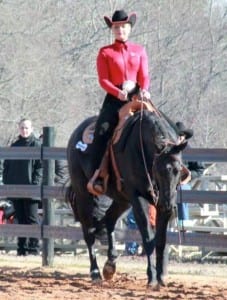 Nottingham suggested, “Develop as many basic riding skills as you can. My basic riding skills have gotten me through a lot. Also, a lot of girls come in without the familiarity of working out. I recommend familiarizing yourself with a gym or playing some other sport to get used to it.”
Nottingham suggested, “Develop as many basic riding skills as you can. My basic riding skills have gotten me through a lot. Also, a lot of girls come in without the familiarity of working out. I recommend familiarizing yourself with a gym or playing some other sport to get used to it.”
Author’s Note: Like any other sport at the collegiate level, equestrian team members are required to follow the workout regimen specified by their school/coach. It doesn’t just start and stop down at the barn.
“Know that coaches are watching you while scouting you both inside and outside the pen,” Morgan noted, “If you have a bad attitude, you may not be invited to join the team. If you want it, you have to show it… all the time.”
“It’s also never too early to get on coaches radars,” said Anderson, “send videos of you riding early if it’s something you really want.”
Walking the Balance Beam
Between school work and being on the equestrian team, you may think these women have little time for anything else. Unbelievably however, all of them still show in their respective breeds to varying degrees.
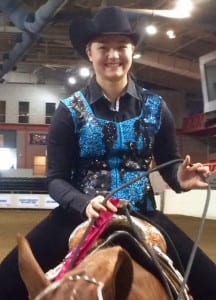 McMullen currently has two 4 year-olds she is preparing to show in the Amateur Western Pleasure while Morgan has a Ranch Riding/Trail horse, Spark N Big Guns, that she shows when she can (in fact, she was the 2015 APHA Amateur Ranch Riding World Champion).
McMullen currently has two 4 year-olds she is preparing to show in the Amateur Western Pleasure while Morgan has a Ranch Riding/Trail horse, Spark N Big Guns, that she shows when she can (in fact, she was the 2015 APHA Amateur Ranch Riding World Champion).
Nottingham and Anderson show less (mostly in the summer) but all of these women plan on getting back in the show pen upon graduation.
This all obviously begs the question: how do they do it?!
In one word: calendars.
Oh, and mom.
“I couldn’t do it without my mom,” said Nottingham, “she’s constantly looking at the calendar. Your first commitment is to the team, so you have to make sacrifices and be realistic. Sometimes it’s difficult, but you have to for your own sanity.”
What Nottingham is referring to is the fact that, let’s say your team has a meet in the middle, of well, World Show. That means if you choose to show at World Show you will have to leave to make it to your meet as that comes before individual showing.
This is exactly what happened to Morgan during 2015.
“I couldn’t show in the Open because I had to leave for a meet,” she recalled.
Still Successful
It’s really no surprise that all four of these outstanding youth competitors have continued to enjoy success at the collegiate level.
 Anderson was named SEC Freshman of the Year in 2014 and in 2015 she won the AQHA Collegiate Horsemanship Challenge.
Anderson was named SEC Freshman of the Year in 2014 and in 2015 she won the AQHA Collegiate Horsemanship Challenge.
McMullen’s team accomplishments include: second team All-American, a two time finalist in the Horsemanship challenge at the AQHA World Show, 2015 Academic All-Big 12 Second Team, and she has been the Big 12 Horsemanship Rider of the Month four times.
Nottingham was named Big 12 Rider of the Month in October 2014 and has also been elected team captain by her teammates for both the 2014-2015 and 2015-2016 seasons.
Morgan was named the Big 12’s Rider of the Month in February of 2013. She was also named The Most Outstanding Player in Horsemanship the same year.
After speaking with each one of these fine young women, it became clear that while their experiences on a collegiate equestrian team all shared some similarities, they are all incredibly unique and there is little doubt that they all have bright futures ahead of them, both in and out of the show pen.









